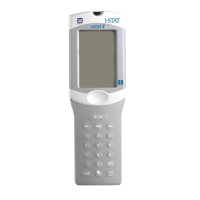14-4 Art: 714376-00M Rev. Date: 31-Jan-12
Ampule Use
When using cartridges that contain sensors for pH, PCO
2
, PO
2
and ionized
calcium,aseparateampulemustbeusedforeachcartridgebeingtested.
Donotusethesolutionleftinasyringe,ampuleorcapillarytubeforadditional
testingofcartridgesthatcontainsensorsforionizedcalcium,pH,PCO
2
,orPO
2
.
However,cartridgeswithoutthesesensorsmaybetestedwithremaininguids
ifwithin10minutesofopeningtheampule.
Procedure
STEP ACTION
1 Access the i-STAT Cartridge Control option under Quality Tests in
theAdministrationMenu.Entertherequiredinformation.The
analyzerallows15minutes(orthecustomizedtimeout)toinsert
the cartridge after the last data entry.
2 Immediatelybeforeuse,shaketheampulevigorouslyfor5to10
seconds to equilibrate the liquid and gas phases.
Toshake,holdtheampuleatthetipandbottomwithforenger
and thumb to minimize increasing the temperature of the solution.
Ifnecessary,tapthetipoftheampuletosendsolutionbackinto
the bottom section of the ampule.
3 Protectngerswithgauze,tissueorglove,oruseanampulebreaker
to snap off the tip of the ampule at the neck.
4 Immediately transfer the solution from the ampule into a capillary
tubeorsyringe,andthenimmediatelytransferthesolutionintoa
cartridge.
5 Immediately seal the cartridge and insert it into an analyzer – it is
importantnottoexposethesolutiontoroomairsincethiswillalter
theresults.Note:Sinceaqueousbasedsolutionssuchascontrols
lackthebufferingcapabilitiesofwholeblood,thetransferprocess
from ampule to cartridge must be more expedient than with a
patient sample.
Before Use
i-STAT control solutions require different temperature stabilization times
dependingonwhetherornotoxygenistobemeasured.Ifoxygenistobe
measured,equilibratetheampulefor4hours.Ifnot,equilibratetheampule
forapproximately30minutesatroom(ambient)temperature.
Transfer with Syringe
Plain syringes are recommended to transfer an aqueous control from the ampule
tothecartridge.Whenusingasyringe(fresh1ccor3ccsterilesyringewith
16-20gaugeneedlesarerecommended),slowlydrawapproximately1mLof
solution from the bottom of the ampule.
Ifairistrappedbetweentheleadingedgeofthesolutionandtheplunger,do
notinvertthesyringetoexpelit;thiswillnotaffectsolutionnearthetipof
the syringe.
Ifairbubblesarecontinuallydrawnintothesyringe,orifabubbleistrapped
nearthe tipofthe syringe,discardthe ampuleandsyringe andusea fresh
ampule and syringe.
Expeloneortwodropsfromthesyringebeforellingthecartridge.
Transfer with Capillary
Tube
Plain capillary tubes are recommended to transfer an aqueous control from the
ampuletothecartridge.Whenusingacapillarytube(freshcapillarytubeswith
sufcientllcapacityarerecommended),llfromthebottomoftheampule
toavoiddrawingairintothecapillarytube.Avoiddrawingsolutionfromthe
surface by placing a finger over the far end of the tube as it is inserted into the
ampule.Oncetheopenendofthetuberestsatthebottomoftheampule,
uncovertheotherendtoallowllingbycapillaryaction.

